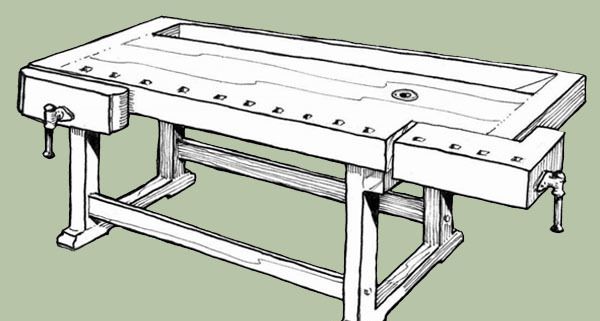The Workbench
An illustrated guide to an essential woodworking tool
Synopsis: This richly illustrated article traces the evolution of what some consider the most important tool of the craft, the workbench. A closer appreciation of its uses and strengths can do much to improve your woodworking experience. Here is a look at its development and many variations, as well as the fixtures associated with it: vises, benchdogs, bench stops, holdfasts, and bench hooks.
In some parts of the world, woodworkers use the floor as their work surface. In Japan, it’s a narrow beam. But in the West, woodworkers traditionally have used a substantial workbench. In fact, before tablesaws and routers became for most woodworkers their right and left hands, the workbench was the most important tool of the craft. While it may no longer be the first tool a woodworker encounters in the shop, the workbench nevertheless remains at the heart of woodworking. A closer appreciation of its uses and strengths can do much to improve your woodworking experience, so here’s a look at the development of the workbench, its major variations and the many practical fixtures associated with its use.
Roman Bench- The prime purpose of the workbench is to facilitate the flattening and smoothing of stock, typically by planing. So it is no surprise that some of the earliest benches were used by the Romans 2,000 years ago, because it was the Romans who first made use of the metal-bodied plane. The Roman bench was little more than a long board supported by splayed legs and fitted with stops to prevent a board from being pushed off the bench during planing. This bench remained popular for more than four centuries after the demise of the Roman Empire and in some areas persists even today. The drawing is based on a photograph of a bench found in Saalburg, Germany, 250 B.C.
16th Century Bench- After the Middle Ages, with the development of more sophisticated forms of furniture, benches grew larger and began to feature additional holding devices. By the 17th century, vises had become common in Northern Europe. German and Scandinavian benches, in particular, were fitted with vises very similar to the large wooden tail and face vises that were common on British benches until the introduction of metal vises. The drawing is based on one by Loffelholz, 1505.
From Fine Woodworking #160
For the full article, download the PDF below:
Fine Woodworking Recommended Products

WoodRiver Router Bit Storage Case

Drafting Tools

Circle Guide






















Log in or create an account to post a comment.
Sign up Log in